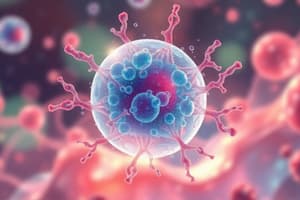Podcast
Questions and Answers
The science of microbiology really developed in the ______ century.
The science of microbiology really developed in the ______ century.
nineteenth
Robert Hooke illustrated the fruiting structures of ______ in his book Micrographia.
Robert Hooke illustrated the fruiting structures of ______ in his book Micrographia.
molds
The first known description of microorganisms was made by ______ in Micrographia.
The first known description of microorganisms was made by ______ in Micrographia.
Hooke
Antoni van Leeuwenhoek was the first person to see ______.
Antoni van Leeuwenhoek was the first person to see ______.
Signup and view all the answers
Van Leeuwenhoek's microscopes were considered ______ by today's standards.
Van Leeuwenhoek's microscopes were considered ______ by today's standards.
Signup and view all the answers
Van Leeuwenhoek discovered bacteria while studying ______ infusions.
Van Leeuwenhoek discovered bacteria while studying ______ infusions.
Signup and view all the answers
Microbiology owes much to its ______.
Microbiology owes much to its ______.
Signup and view all the answers
Hooke’s famous book published in 1665 was titled ______.
Hooke’s famous book published in 1665 was titled ______.
Signup and view all the answers
In 1684, van Leeuwenhoek examined the microbial content of a variety of ______.
In 1684, van Leeuwenhoek examined the microbial content of a variety of ______.
Signup and view all the answers
The round structures in Hooke's drawings were called ______.
The round structures in Hooke's drawings were called ______.
Signup and view all the answers
Study Notes
Historical Roots of Microbiology
- Microbiology's development accelerated in the nineteenth century, but its origins date back much earlier.
- Early hypotheses about tiny creatures were confirmed with the invention of the microscope.
Key Figures
-
Robert Hooke (1635–1703):
- English mathematician and natural historian known for significant contributions to microscopy.
- Author of Micrographia (1665), the first book dedicated to microscopic observations.
- Provided the first known description of microorganisms by illustrating fruiting structures of molds.
-
Antoni van Leeuwenhoek (1632–1723):
- Dutch draper and amateur microscopist who was the first to observe bacteria.
- Developed simple, yet effective microscopes and discovered bacteria in 1676 while studying pepper-water infusions.
- Known for referring to microorganisms as "wee animalcules" in correspondence to the Royal Society of London, published in 1684.
Microscopy Innovations
- Hooke’s microscope (depicted in his book) was a key advancement in the observation of small life forms.
- Van Leeuwenhoek's microscopes were crude compared to modern standards, yet effective through precise manipulation and focusing techniques.
- The significance of van Leeuwenhoek's findings was not fully understood for nearly 150 years after his initial observations.
Studying That Suits You
Use AI to generate personalized quizzes and flashcards to suit your learning preferences.
Description
Explore the historical development of microbiology, focusing on key figures such as Hooke, van Leeuwenhoek, and Cohn. This quiz highlights the evolution of the science from its roots in the nineteenth century to its modern advancements and related fields.




